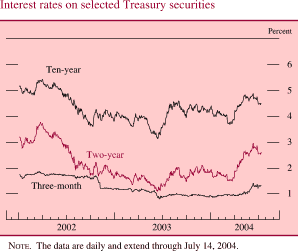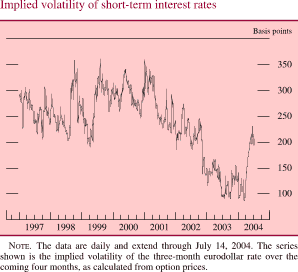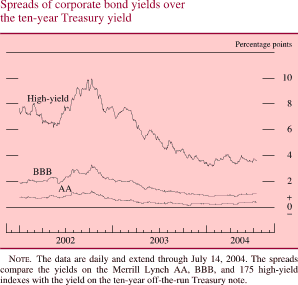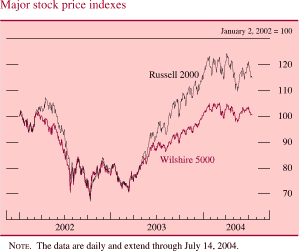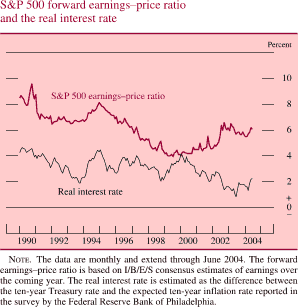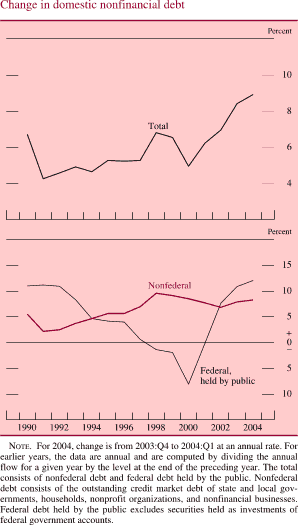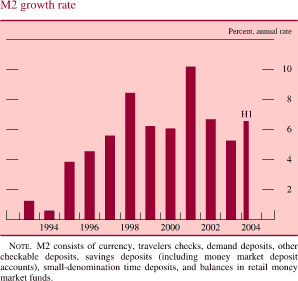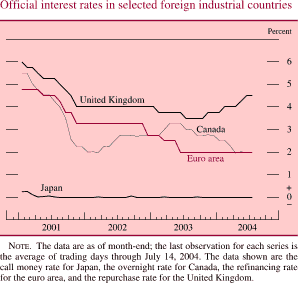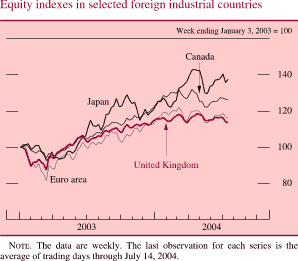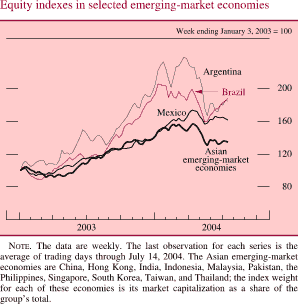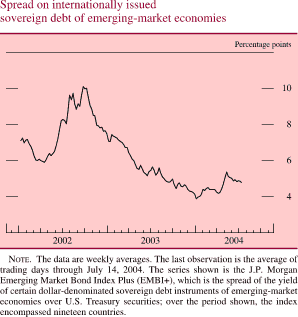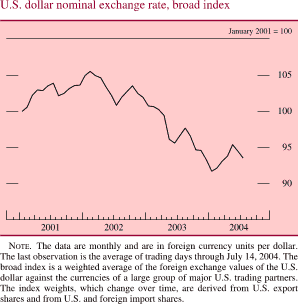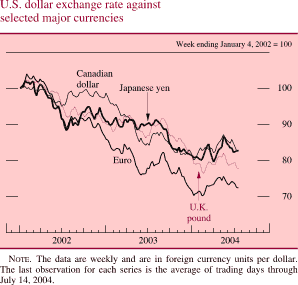
Monetary Policy Report submitted to the Congress on July 20, 2004, pursuant to section 2B of the Federal Reserve Act
Section 2
ECONOMIC AND FINANCIAL DEVELOPMENTS IN 2004
After having surged in the second half of 2003, economic activity continued to expand at a solid pace in the first half of 2004. In the labor market, payroll employment started to increase last fall after a long string of declines and picked up further during the first half of this year. Headline inflation has been boosted significantly by the jump in energy prices this year, but core inflation has also moved up from the exceptionally low levels of late 2003.
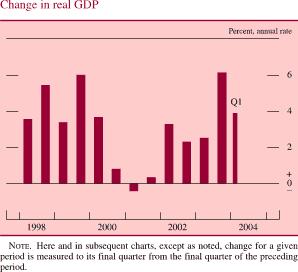
The Household Sector
Consumer Spending
Consumer spending, which had gathered a good bit of steam in the second half of 2003, continued to move higher in the first half of 2004. The growth in spending was spurred by substantial gains in income. In addition, household wealth has risen sharply over the past year, and consumer surveys indicate that individuals are generally upbeat in their assessments of the economy's prospects and of their own situations.
Personal consumption expenditures rose at an annual rate of 3-3/4 percent in real terms in the first quarter. Spending on light motor vehicles, which had been supported in late 2003 by aggressive price and financing incentives, slipped somewhat in early 2004. But outlays for goods other than motor vehicles, which had risen 6-1/2 percent in real terms in 2003, posted another huge increase in the first quarter; spending on services also perked up after having advanced only modestly in 2003. The available data point to a much smaller increase in consumer spending in the second quarter; the deceleration mainly reflects a sharp slowing in the growth of outlays on goods other than motor vehicles.
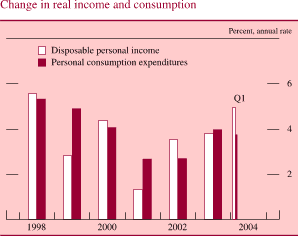
Real disposable personal income (DPI)--that is, after-tax income adjusted for inflation--rose at an annual rate of nearly 4 percent between the fourth quarter of 2003 and May 2004, a gain about in line with its rate of growth last year. To be sure, the rise in energy prices cut into the growth of real income in the first half of the year. However, aggregate wages and salaries, boosted by increases in both employment and earnings, rose appreciably in nominal terms. In addition, last year's tax legislation, which had already reduced withholding rates in mid-2003, added further to households' cash flow by increasing refunds and lowering final settlements this spring.
Household wealth increased only about in line with nominal DPI in the first quarter of 2004, and the wealth-to-income ratio was likely little changed in the second quarter as well. Nonetheless, the increase in wealth over the past year has been considerable--and probably large enough to more or less offset any lingering restraint on spending growth from the earlier declines in stock prices. Thus, with wealth approximately a neutral influence on the growth of spending of late, the personal saving rate has held fairly steady. In fact, the average saving rate over the first five months of the year--at 2-1/4 percent of DPI--was very close to the annual figures for 2002 and 2003.
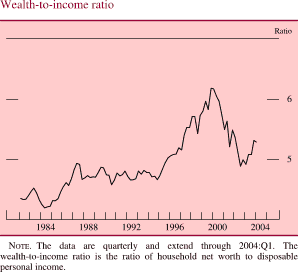
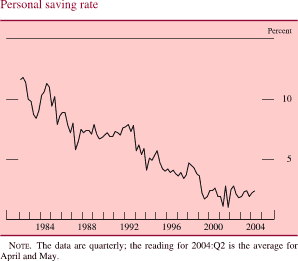
Residential Investment
Activity in the housing sector remained torrid in the first half of 2004. Although starts in the single-family sector faltered a bit early in the year, in part because of unusually adverse weather, they subsequently snapped back and reached an annual rate of more than 1.6 million units in April and May--8-1/2 percent greater than the already rapid pace for 2003 as a whole. Sales of new and existing homes have also been exceptionally strong, and they hit record highs in May. In general, housing activity has been supported by the favorable developments regarding jobs and income and, especially early in the year, by low mortgage rates. Rates on thirty-year fixed-rate mortgages, which had dipped to 5-1/2 percent in March, rose markedly in the spring; they have edged down in recent weeks and now stand at 6 percent, a level still quite low by historical standards.
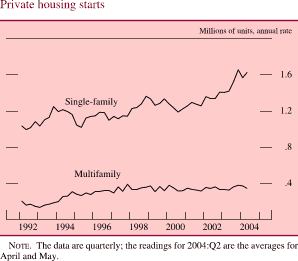
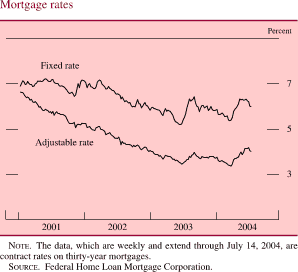
Home prices have continued to rise rapidly. For example, the national repeat-sales price index from the Office of Federal Housing Enterprise Oversight--which partially adjusts for shifts in the quality of homes sold--rose 7-3/4 percent over the year ending in the first quarter (the latest available data), a rate similar to the average annual gain since late 2000. By this measure--and many others--house price increases have outstripped gains in incomes as well as in rents in recent years.
Starts in the multifamily sector averaged an annual rate of 360,000 units over the first five months of the year, a pace slightly faster than that of the past several years. Low interest rates have apparently helped maintain the profitability of apartment construction, given that other fundamental determinants of activity in the sector have been weak: In particular, rents have remained soft, and in the first quarter, vacancy rates for multifamily rental properties reached a new high.
Household Finance
Household debt rose at an annual rate of about 10-3/4 percent in the first quarter of 2004. The especially rapid growth of mortgage debt was driven by the strong pace of activity in the housing market and the renewed wave of mortgage refinancing. However, the second-quarter rise in interest rates appears to have slowed the rate of refinancing and, consequently, the amount of equity being extracted from the value of homes through such transactions. Consumer credit--which constitutes the bulk of household debt aside from mortgage borrowing--expanded at an annual rate of about 6 percent over the first quarter of the year and at roughly a 4 percent pace in April and May. The growth of consumer credit likely has continued to be restrained by the substitution toward mortgage debt as a means to finance household expenditures.

Low interest rates, in concert with strong growth in disposable personal income, have helped to keep financial obligations manageable for most households. In the first quarter of the year, the debt service ratio and the financial obligations ratio for the household sector in the aggregate, both of which gauge pre-committed expenditures relative to disposable income, continued to edge down from their peaks in 2001. Other indicators also suggest that the financial well-being of households has stabilized and may be improving. Delinquencies on credit card and auto loans generally declined in the first three months of the year, and bankruptcy rates, while still high, stepped down in the first quarter from their recent peak.
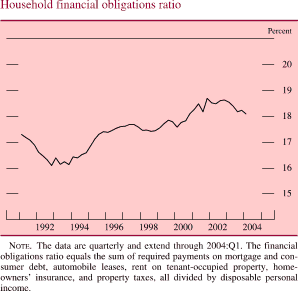

Rapid increases in home prices have continued to buoy household net worth this year. In contrast, stock prices are about unchanged. Although news on earnings and economic activity has generally been favorable, rising oil prices and interest rates and, perhaps, heightened geopolitical concerns have weighed on investor sentiment. Nevertheless, inflows into equity mutual funds have been even stronger thus far in 2004 than they were last year.
The Business Sector
Fixed Investment
For the most part, businesses appear to be shaking off the extraordinary reluctance to undertake new investment projects that was evident in 2002 and 2003. Indeed, although outlays on nonresidential construction have not yet turned up decisively, real spending on equipment and software (E&S) has been advancing briskly. The broadly based growth in E&S spending has been driven by increasingly favorable fundamentals: positive expectations for sales, high levels of corporate profits and cash flow, a desire to replace or upgrade aging equipment after a period of weak investment spending, and the continued low cost of capital.
Real E&S spending rose at an annual rate of more than 15 percent in the second half of last year, and it posted another sizable increase in the first quarter of 2004 despite flat business purchases of motor vehicles and a dip in deliveries of aircraft. Excluding transportation equipment, real spending on E&S rose at an annual rate of 13-1/2 percent in the first quarter. In the high-tech category, real purchases of computers and software remained on the solid uptrend that has been evident for the past couple of years, and real outlays on communications equipment increased further, reaching a level about 20 percent above the low in the fourth quarter of 2002. Spending for equipment other than high-tech and transportation, which accounts for about 40 percent of E&S (measured in nominal terms), also rose markedly in the first quarter. Such spending tends to be particularly sensitive to the prospects for aggregate demand. In addition, it may be receiving a lift from the partial-expensing tax provision, which is especially valuable for equipment with relatively long service lives for tax purposes; that provision is slated to expire at the end of 2004.
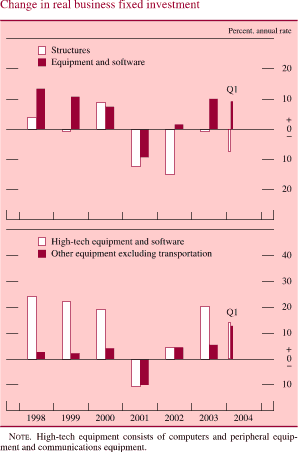
Equipment spending appears to have posted another solid increase in the second quarter. Outlays on transportation equipment seem to have rebounded, and the incoming data on high-tech equipment point to robust real expenditures. Some indicators for spending on other nontransportation equipment have been a bit soft recently. But the May level of shipments for this broad category was still above that of the first quarter, and backlogs of unfilled orders, which have risen impressively over the past year, continued to build.
Real nonresidential construction has remained about unchanged, on net, since the steep decline in 2001 and 2002. Construction of office buildings is still running at roughly half the pace of 2000, although vacancy rates have stabilized--albeit at very high levels--and the decline in rents has slowed. Factory construction also remains sluggish. Construction of retail and wholesale facilities, in contrast, has held up fairly well, a performance consistent with the strength in consumer spending. Outlays on buildings for health care and education also have been reasonably well sustained.
Inventory Investment
Inventory investment has generally remained subdued even as final sales have strengthened. Although real nonfarm inventory investment picked up to an annual rate of $30 billion in the first quarter, the accumulation occurred almost entirely in the motor vehicle sector, in which sagging sales and a high level of production early in the year created a noticeable bulge in dealer stocks, especially of light trucks. In the second quarter, the automakers reduced assemblies; but with sales running only a little above their first-quarter pace on average, inventories of motor vehicles remained elevated. Outside the motor vehicle industry, nonfarm inventories increased at a meager $6 billion annual rate in real terms in the first quarter, and the available data point to only a moderate step-up in real stockbuilding, on balance, in April and May. In general, non-auto inventories appear lean relative to sales, even after factoring in the downward trend in inventory-sales ratios that has accompanied the ongoing improvements in supply-chain and logistics management.
Corporate Profits and Business Finance
Continuing the gains of last year, profits of the business sector to date have remained strong. In the first quarter of 2004, earnings per share for S&P 500 firms were about 26 percent higher than their level four quarters earlier, and before-tax profits of nonfinancial corporations as a share of GDP from that sector edged up following a steep increase in 2003. A jump in profits in the petroleum and gas industries owing to higher oil prices was responsible for much of the rise in earnings. However, firms across many industries, with the notable exception of telecommunication services, registered solid gains in earnings. In response to this pattern of higher profits, analysts have been steadily marking up their forecasts for earnings in subsequent quarters.
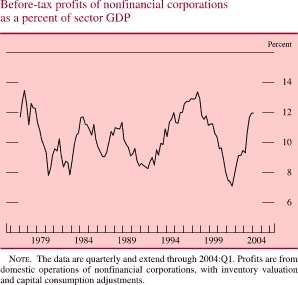
Net equity issuance has remained negative this year. Seasoned offerings have been scarce, the pace of initial public offerings has only inched up, and share retirements have continued to be strong. Corporations have continued to repurchase shares at a rapid rate to manage their cash positions, even as they have increased dividend payments.
Firms relied heavily on their elevated profits and substantial cash holdings to finance their investment in inventories and fixed capital in the first half of 2004. As a result, the growth of nonfinancial business debt remained modest. Much of the proceeds from bond issuance was used to pay down higher-cost debt, and the timing of the issuance of investment-grade bonds in particular was influenced by movements in interest rates; issuance spiked in March in the wake of the drop in yields but subsided in April as rates rebounded. Short-term debt financing showed signs of turning around after contracting over the previous three years. Commercial paper outstanding expanded in the first two quarters of 2004. Business loans at banks have fallen on balance so far this year but at a much slower pace than in 2003. The Federal Reserve's Senior Loan Officer Opinion Survey conducted in April 2004 indicated that demand for business loans had begun to expand and that commercial banks had again eased both standards and terms on these loans over the previous three months.
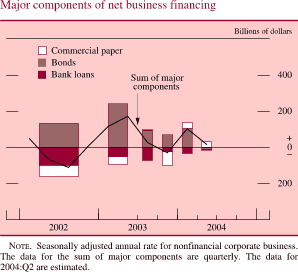
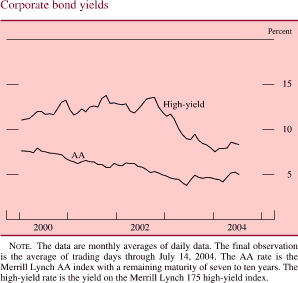
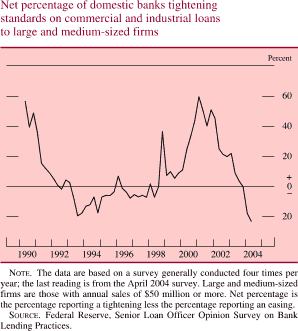
Strong profits, low interest rates, and continued deleveraging helped improve the credit quality of nonfinancial firms over the first half of the year. In the second quarter, the delinquency rate on business loans dropped for the sixth consecutive quarter; the continued decline has reversed a large part of the preceding run-up. Early in the year the twelve-month trailing default rate on outstanding bonds fell into the relatively low range observed over much of the 1990s, and in June it registered another decline. Moreover, in the first part of the year, the pace of upgrades of bond ratings by Moody's Investors Service rose while the pace of downgrades fell.
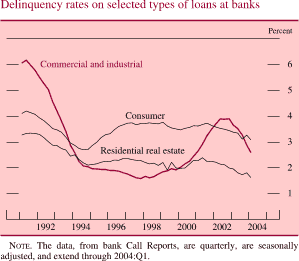
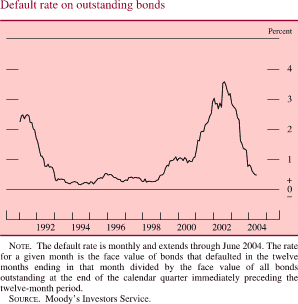
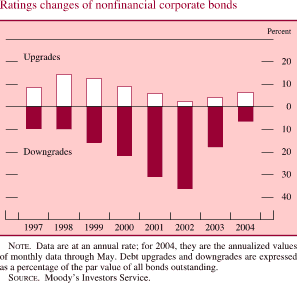
Borrowing against commercial real estate assets continued at a rapid pace during the first half of this year. Anecdotal reports suggest that some firms were using mortgages on commercial property to lock in low-cost, long-term funding. Despite the persistently high vacancy rates for most types of commercial property, the loans backed by these assets have continued to perform well. Delinquency rates on commercial mortgages held by banks and insurance companies remained very low in the first quarter. A drop in delinquencies on commercial-mortgage-backed securities (CMBS) in recent months has partially reversed last year's rise, and the narrow risk spreads on CMBS suggest that investors have limited concerns about loan quality.
The Government Sector
Federal Government
The deficit in the federal unified budget has continued to widen. Over the twelve months ending in June, the unified budget recorded a deficit of $431 billion, $120 billion more than during the comparable period last year and equal to nearly 4 percent of nominal GDP. In large part, the rise in the deficit is attributable to further rapid increases in spending on defense and other programs and the loss of revenues resulting from the tax legislation enacted in recent years. In addition, interest costs, which fell sharply between fiscal 1997 and fiscal 2003 as a result of budget surpluses and declining interest rates, have leveled off and thus are no longer a significant factor helping to restrain the deficit. The primary deficit, which excludes net interest, totaled $276 billion over the twelve months ending in June, also approximately $120 billion more than over the year ending in June 2003.
Over the twelve months ending in June, nominal federal spending was nearly 7 percent higher than during the same period a year earlier and stood at about 20 percent of nominal GDP--virtually the same as in fiscal 2003 but 1-1/2 percentage points above the recent low in fiscal 2000. Spurred by the war in Iraq, defense spending ramped up another 14 percent; outlays for nondefense discretionary programs, which include homeland security, moved up further as well. Spending on the major health programs rose at a rapid clip, in part because the Jobs and Growth Tax Relief Reconciliation Act of 2003 (JGTRRA) temporarily increased grants to the states under the Medicaid program and boosted payments to some Medicare providers. In addition, as noted, net interest payments, which had plummeted between 1997 and 2003, flattened out. Real federal expenditures for consumption and gross investment--the part of government spending that is a component of real GDP--rose at an annual rate of 8-1/2 percent in the first calendar quarter of 2004; that increase reflected a surge in real defense spending, which now stands more than 30 percent above the levels that prevailed, on average, from 1997 to 2000.
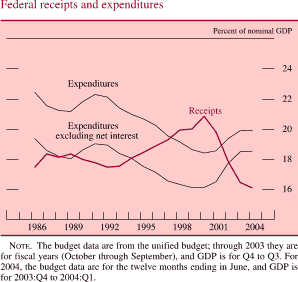
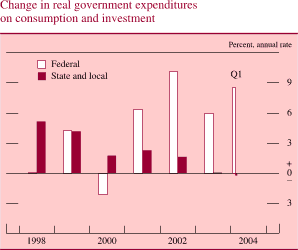
Federal receipts in the twelve months ending in June were 1-1/2 percent higher than during the comparable period of the previous year after having fallen markedly between fiscal 2000 and fiscal 2003. Receipts received a substantial boost over the past year from a strong gain in corporate taxes, which were lifted by robust profits. Social insurance taxes, which tend to move in line with wages and salaries, also increased. But individual income taxes were below last year's level: Although taxable incomes rose moderately, collections were reduced by the lower withholding rates in place since mid-2003 and by the effects of JGTRRA on refunds and final settlements this spring.
The deterioration in the unified budget since 2000 has been mirrored in a sharp downswing in federal saving--essentially, the unified surplus or deficit adjusted to conform to the accounting practices followed in the national income and product accounts (NIPA). Gross federal saving fell from a high of nearly 3 percent of nominal GDP in 2000 to negative 3 percent of GDP in the first quarter of 2004; measured net of estimated depreciation, federal saving fell from 2 percent of GDP to negative 4 percent of GDP over this period. In the past couple of years, the rise in business saving from the rebound in profits and reductions in corporate taxes has cushioned to some extent the effect of growing budget deficits on national saving. In fact, because of the dramatic increase in business saving in recent quarters, national saving has recovered some from the extreme lows of early 2003. Even so, as of the first quarter of 2004, national saving (measured net of estimated depreciation) was still equal to just about 2-1/2 percent of GDP, compared with a recent high of 6-1/2 percent in 1998. If not reversed over the longer haul, such low levels of national saving could eventually impinge on private capital formation and thus slow the rise of living standards.
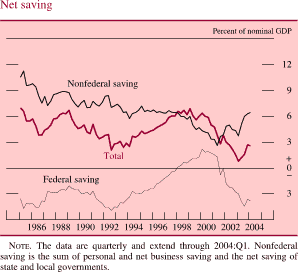
Reflecting the need to finance the sizable federal budget deficit, federal debt held by the public expanded at an annual rate of 11-3/4 percent in the first half of the year. The ratio of this debt to nominal GDP now exceeds 36 percent. The Treasury tilted its issuance toward longer-term and inflation-indexed securities somewhat, and announced semiannual issuance of a twenty-year inflation-protected bond beginning in July and a five-year inflation-protected note beginning in October.
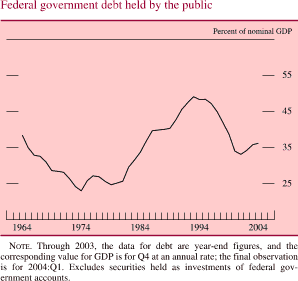
State and Local Governments
States and localities have started to see some improvement in their budget positions after having gone through several difficult years. Strong growth in household income and consumer spending has boosted revenues in recent quarters, as have the additional federal grants authorized under JGTRRA. And although rising medical costs and security needs have continued to put upward pressure on spending, state and local governments have generally held the line on hiring and have kept other outlays in check. The restraint on spending, in combination with a drawdown of reserve funds and some increases in taxes, has helped states and localities satisfy their balanced-budget requirements. In fact, between the third quarter of 2003 and the first quarter of 2004, NIPA net saving (excluding social insurance funds) for this sector averaged $21 billion at an annual rate (1/4 percent of nominal GDP), compared with negative $7 billion in 2002 and negative $31 billion in the first half of 2003. (Net saving is roughly similar to the surplus or deficit in an operating budget.) Although a few states are still struggling with strained fiscal situations, most have entered fiscal 2005 (which started on July 1 in all but four states) with expectations of respectable growth in revenues and with budgets in place that allow for some increases in spending on high-priority services and some rebuilding of reserve funds.
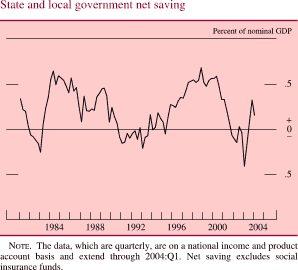
Real consumption and investment spending by state and local governments was essentially flat in the first quarter of 2004; available indicators point to a moderate increase in the second quarter. Outlays for consumption items, which were little changed in 2003, appear to have remained subdued throughout the first half of the year. Investment expenditures also were about unchanged in the first quarter, but they turned up sharply in the spring, mainly because of a jump in spending on highways.
Significant demand for infrastructure spending and favorable interest rates led to robust issuance of state and local government debt to finance capital expenditures and to advance refund higher-cost debt. Nevertheless, over the first half of the year, net issuance edged down from its rapid pace in 2003 to about a 6 percent annual rate. The deceleration reflected a decline in short-term borrowing as improvements in the fiscal positions of state and local governments lessened the need for temporary funding of budget shortfalls.
The credit quality of municipal borrowers has stabilized after two years of deterioration; for the year to date, upgrades and downgrades of credit ratings have been roughly equal. In a marked change from last year's sentiment, rating agencies have begun to express guarded optimism about the credit quality of states because of improvements in state revenue flows and restraint on spending.
The External Sector
In the first quarter of 2004, the U.S. current account deficit expanded to an annual rate of $580 billion, or about 5 percent of GDP. As in the past, the widening was driven primarily by a larger deficit in trade of goods and services. The surplus on net investment income declined in the first quarter but remained well above its average value in the previous year. The deficit on net unilateral transfers rose because of a concentration of disbursements of government grants in the first quarter.
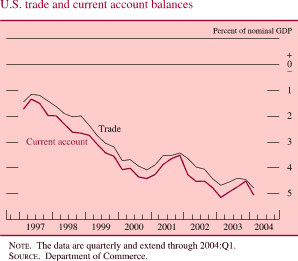
International Trade
The U.S. trade deficit in goods and services registered $548 billion at an annual rate in the first quarter, about $46 billion larger than in the fourth quarter of 2003. On average, data for April and May suggest that the trade deficit continued to widen in the second quarter.
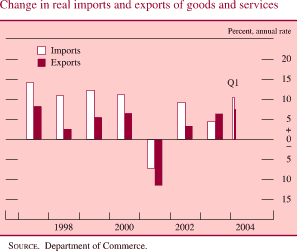
Real exports of goods and services increased at an annual rate of 7-1/2 percent in the first quarter of 2004, well off the blistering 20 percent pace of the fourth quarter but still above the average for 2003. Solid gains in exports since mid-2003 arose in part from the strong economic performance of many of our major trading partners. In addition, the net decline in the exchange value of the dollar since 2002 continued to make U.S. goods and services more competitive abroad. Increases in exports of U.S. goods were widespread across our major trading partners, with the exception of Japan, and were concentrated in real exports of capital goods, industrial supplies, and consumer goods. Real exports of agricultural products fell sharply, hurt by foreign bans on U.S. beef products following reports of mad cow disease in a U.S. herd. Exports of services rose moderately.
Prices of total exports rose at an annual rate of 5-3/4 percent in the first quarter, boosted by another jump in agricultural prices along with substantial increases in the prices of other primary commodities and industrial supplies. Prices of U.S. agricultural exports have been pushed up by very strong global demand, particularly from China. For specific products, such as cotton and soybeans, lower production in some countries also contributed to price run- ups. More recently, prices of soybeans and other agricultural products have eased in the face of a slowing in the growth of demand from China and the anticipation of larger harvests. Even so, available data point to continued strong increases in export prices in the second quarter.
Supported by solid U.S. economic growth, real imports of goods and services rose at an annual rate of 10-1/2 percent in the first quarter. This increase was below the fourth-quarter pace but still roughly double the rate of increase for 2003 as a whole. Real imports of goods were boosted by a sharp increase in oil imports. Gains in imports of non-oil goods were also sizable and widespread across categories. Imports of services grew slightly in the first quarter.
The spot price of West Texas intermediate (WTI) crude oil surged above $40 per barrel in May and has since fluctuated close to that level. The run-up in the price since the beginning of the year has been driven by surprisingly strong global demand for oil. Supply issues have been important as well. These were mainly continued violence in Iraq, including the sabotage of oil facilities, attacks on foreigners in Saudi Arabia, ongoing unrest in Nigeria, political turmoil in Venezuela, and tax payment difficulties at a major Russian oil company. The recent increase in OPEC production (mainly by Saudi Arabia) has eased the upward pressure on prices a bit, but they have remained elevated.
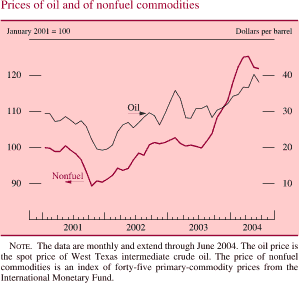
Prices of imported non-oil goods rose at an annual rate of 5-1/2 percent in the first quarter after minimal increases in the second half of 2003. Prices for imported consumer goods rose at an annual rate of 2-3/4 percent after being flat in 2003. Skyrocketing global commodity prices last year and early this year boosted prices of imported industrial supplies (especially metals) and of foods, feed, and beverages. The jump in commodity prices reflected strong demand, the net depreciation of the dollar over the past two years, and the limited expansion in supply of many commodities since the 2001 trough in commodity prices. Available data suggest a modest step-down in the rate of increase of import prices in the second quarter; the move in part reflects a flattening of consumer goods prices.
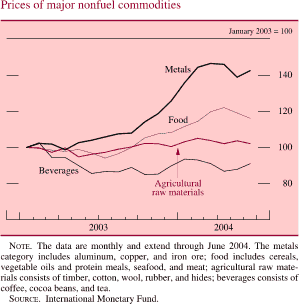
The Financial Account
The U.S. current account deficit has continued to be financed largely by foreign flows into U.S. bonds. Foreign official inflows, already sizable in 2003, rose sharply in the first quarter of 2004 and then moderated somewhat. Similarly, private foreign purchases of U.S. bonds, which were significant in 2003, increased sharply in the first quarter and also appear to have moderated in the second quarter. In contrast, foreign demand for U.S. equities was weak in 2003 and has remained so in 2004. Purchases of foreign equities by private U.S. investors appear to be strengthening, but U.S. investors still show no appetite for foreign bonds.
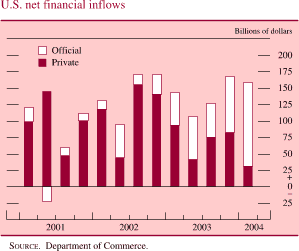
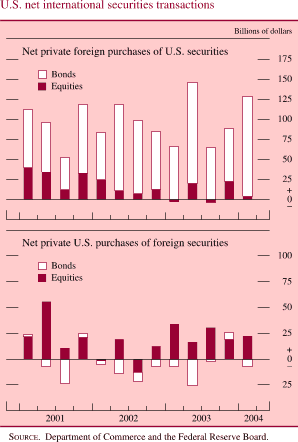
Direct investment into the United States in the first quarter continued to be restrained by the slowdown of global mergers and acquisitions since 2002. In contrast, U.S. direct investment abroad was strong in 2003 and in the first quarter of 2004, as the effect of fewer mergers and acquisitions was offset by sizable reinvested earnings.
The Labor Market
Employment and Unemployment
The demand for labor turned up in late 2003 after an extended period of weakness, and it has gathered additional steam this year. After averaging about 60,000 per month in the fourth quarter of 2003, gains in private nonfarm payroll employment rose to an average of about 200,000 per month in the first half of 2004. The job gains were especially large in March, April, and May but ebbed somewhat in June. The civilian unemployment rate, which had fallen from a recent peak of 6.3 percent in June 2003 to 5.7 percent in December 2003, was little changed over the first half of the year. In June, it stood at 5.6 percent.
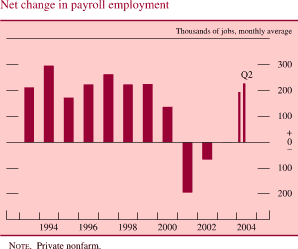
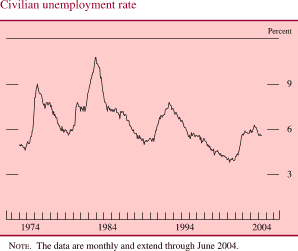
The increases in payrolls over the first half of 2004 were widespread. Especially notable was the turnaround in the manufacturing sector, in which employment bottomed out in January and then rose a cumulative 65,000 jobs through June. The rise in manufacturing jobs was concentrated in the durable goods industries--in particular, those making fabricated metals and other construction-related products, computers and electronic equipment, and machinery. After a long string of declines, employment at producers of nondurable goods was little changed, on net, over the first half. Job gains in virtually all other major sectors have been greater this year than last. In particular, hiring in retail trade, which had been lackluster in 2003, turned up appreciably, and construction employment increased further. The professional and business services sector also posted a sizable rise, in part because the rebound in manufacturing activity lifted hiring at temporary-help firms. A clear indication of the breadth of the employment increases is provided by the six-month diffusion index compiled by the Bureau of Labor Statistics (BLS). The index is equal to the percentage of industries that increased employment over the most recent six months plus one-half the percentage with unchanged employment; in June, the index moved up to its highest level since April 2000.
Productivity and Labor Costs
Gains in labor productivity have slowed somewhat in recent quarters after the spectacular increases of mid-2003. Still, according to the currently published data, output per hour in the nonfarm business sector rose a remarkable 5-1/2 percent over the year ending in the first quarter. Over the past three years, increases in productivity have averaged more than 4 percent per year, compared with average increases of about 2-1/2 percent per year in the second half of the 1990s. During that earlier period, an expansion of the capital stock was an important source of productivity growth. However, in the more recent period, when the business environment--at least until the past few quarters--was characterized by sluggish demand, lean capital budgets, and an extraordinary reluctance of firms to add to payrolls, businesses appear to have raised their productivity mainly through changes in organizational structures and better use of the capital already in place. With hiring having picked up of late, measured productivity growth may slow in coming quarters; but if recent experience is any guide, businesses will continue to focus on achieving structural improvements in the efficiency of their operations. The upswing in investment spending now under way also bodes well for sustained favorable productivity performance in the period ahead.
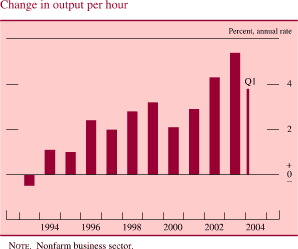
The rapid productivity growth in recent years has helped to bolster increases in hourly compensation in the face of the soft labor market and the low consumer price inflation in 2003. As a result, increases in the employment cost index (ECI) measure of hourly compensation, which is based on a survey of private nonfarm businesses conducted quarterly by the BLS, have held fairly steady of late. In fact, the rise in the ECI over the twelve months ending in March--at a shade less than 4 percent--was virtually the same as the increases over the preceding two years. Benefit costs, which rose 7 percent over the year ending in March, have continued to be the fastest rising portion of hourly compensation; health insurance costs have remained on a steep uptrend, and employers have boosted their contributions to defined-benefit retirement plans to make up for earlier stock market losses. The rising benefit costs have likely exerted some downward pressure on wages, which rose just 2-1/2 percent over the twelve months ending in March; the twelve-month change in the wage component of the ECI, which was close to 4 percent in 2000 and 2001, has been in the range of 2-1/2 percent to 3 percent since late 2002.
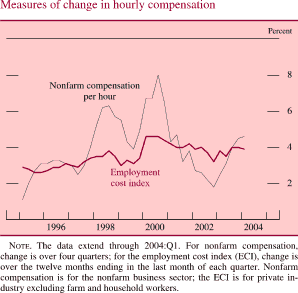
The change in compensation per hour in the nonfarm business (NFB) sector--an alternative measure of hourly compensation based on data constructed for the NIPA--has swung widely in recent years. Fluctuations in the value of stock option exercises, which are excluded from the ECI but included in the NFB measure, likely account for some of the differential movements in the two series. The four-quarter change in the NFB measure bottomed out at a bit less than 2 percent in 2002, when the value of exercised options was dropping; it has moved up steadily since that time and, in the first quarter, stood at 4-1/2 percent--a rate not much different from the increase in the ECI. With productivity growth slowing to a pace below that of NFB hourly compensation, unit labor costs rose in both the fourth and first quarters after having trended down over the preceding two years.
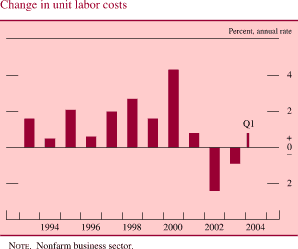
Prices
Inflation moved higher in the first half of 2004. After rising just 1-1/2 percent over the four quarters of 2003, the price index for personal consumption expenditures (PCE) increased at an annual rate of 3-1/2 percent between the fourth quarter of 2003 and May 2004. In that period, energy prices soared, and increases in core consumer prices picked up to an annual rate of 2-1/4 percent--more than 1 percentage point faster than the increase in 2003. Data for the consumer price index (CPI) are available through June and show some moderation in the core component of the series. Over the first half of the year, the core CPI rose at an annual rate of 2-1/2 percent, compared with an increase of 1-1/4 percent over the four quarters of 2003.
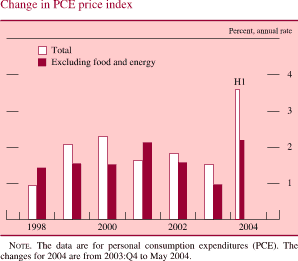
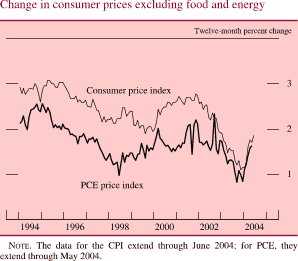
Reflecting the surge in crude oil prices, PCE energy prices rose at an annual rate of more than 25 percent in the first quarter; they apparently posted another outsized increase in the second quarter. Gasoline prices increased rapidly through May as crude oil costs rose and as price markups were boosted by strong demand and lean inventories; although gasoline prices have fallen on balance since late May, they are currently nearly 30 percent above their level at the end of last year. As for natural gas, which can often substitute for fuel oil in the industrial sector, spot prices were elevated at the start of the year, fell somewhat in February and March, and trended up over the spring. The higher spot prices for natural gas this spring pushed up prices paid by consumers through June. PCE electricity prices appear to have risen at an annual rate of 3 percent over the first half of the year, a pace similar to that in 2003.
Although volatile from month to month, consumer food prices rose moderately on balance over the first half of 2004 after having moved up in late 2003. Robust global demand is imparting upward impetus to food prices, but U.S. producers are in the process of boosting supply, which should help restrain increases in retail food prices in coming quarters.
The step-up in core PCE inflation this year has been especially pronounced in a few categories. In particular, prices of motor vehicles have firmed after a noticeable decrease in 2003. In addition, increases in shelter costs, which were surprisingly low in 2003, are now running more in line with earlier trends. Core inflation has also been lifted this year by substantial increases, on balance, in a number of categories for which prices cannot be derived from market transactions and thus must be imputed by the Bureau of Economic Analysis--for example, prices of financial services provided by banks without explicit charge. These non-market-based prices, which were about flat in 2003, are difficult to estimate, and the imputed figures tend to be volatile.
A number of factors have contributed to the run-up in core inflation this year. Higher oil prices have doubtless raised the cost of producing other goods and services. So have the steep increases in prices of non-oil commodities such as copper and lumber, which came about as economic activity strengthened worldwide and as industrial capacity utilization both here and abroad tightened. Likewise, the decline in the dollar has boosted non-oil import prices and thus the costs of inputs for many domestic producers. The weaker dollar has also likely lessened the pressure on firms facing foreign competition to hold the line on prices--a consideration that is probably contributing to the widespread perception that firms' pricing power has increased lately. Moreover, unit labor costs have edged up recently after having declined noticeably in 2002 and 2003.
From a cyclical perspective, the sharp upturn in commodity prices is not surprising, given the pickup in the growth of industrial production. In fact, such large increases in commodity prices are typical as economic activity accelerates and capacity utilization rises--especially for products for which the supply is relatively fixed in the short run. Some portion of these increases usually proves transitory. More important, cyclical swings in commodity prices tend to have only a minor effect on overall inflation, both because they account for a small share of total costs and because changes in commodity prices tend to be partly absorbed in firms' profit margins, at least for a time.
The faster rate of inflation this year underscores the difficulty of gauging price pressures. Nevertheless, on the whole, the evidence suggests that slack remains in labor and product markets, which should be exerting some downward pressure on inflation. The unemployment rate--at 5-1/2 percent currently--is not significantly lower than it was through much of 2002 and 2003, when core inflation was trending down. And despite the run-up this year, capacity utilization in the manufacturing sector is still below its longer-run average. In addition, the strong upward trend in productivity is continuing to help keep the rise in labor costs muted, and profit margins are sufficiently wide to give firms scope to absorb cost increases for a while without putting undue upward pressure on prices.
The upturn in actual inflation has been echoed in some measures of inflation expectations. For example, according to the Michigan Survey Research Center, the median expectation for inflation over the coming year has averaged slightly more than 3 percent since early spring after hovering in the area of 2-1/4 percent to 2-3/4 percent in 2003 and early 2004. The median expectation for inflation over the next five to ten years has been running a bit below 3 percent in recent months, a reading similar to the figures for 2002 and 2003. According to the Survey of Professional Forecasters conducted by the Federal Reserve Bank of Philadelphia, expectations of inflation over the next ten years held steady in June at 2-1/2 percent. Inflation compensation over the next five years as measured by the spread between the yield on nominal Treasury securities and their indexed counterparts rose noticeably during the first half of 2004. To be sure, inflation compensation is also influenced by perceptions of inflation risk and the secular increase in demand for inflation-indexed debt, but the rise in near-term inflation compensation likely reflects, at least in part, higher inflation expectations. Similar to the survey-based measures of longer-run inflation expectations, inflation compensation for the period five years to ten years ahead was little changed on net over the first half of the year.
Broader NIPA price measures are available only through the first quarter, and the four-quarter changes in these series do not show the rise in inflation indicated by the monthly data discussed above. In particular, the rate of increase in the price index for GDP over the year ending in the first quarter was just 1-3/4 percent, the same as over the preceding year. The four-quarter change in the price index for gross domestic purchases--which is defined as the prices paid for purchases of domestic and imported consumption, investment, and government goods and services--dropped from 2-1/4 percent to 1-3/4 percent over the same period; the deceleration reflects mainly the effects of energy prices, which rose even more rapidly over the year ending in the first quarter of 2003 than they did over the most recent year.
